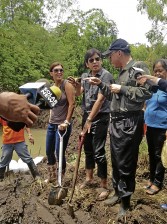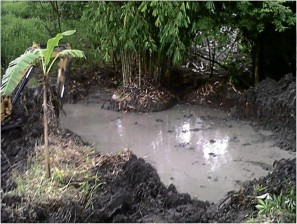Go natural vs floods: Green lawyer bats for rainwater pits in barangays

A POND SOLVES THE PROBLEM Environmental advocate and lawyer Antonio Oposa Jr. (wearing hat) shows Sen. Pia Cayetano and Laguna Rep. Danilo Fernandez how a rainwater catchment system could help alleviate flooding in low-lying areas with minimal government spending. PHOTO BY JAYMEE GAMIL
Addressing the flood problem in Metro Manila could be as simple as digging holes in the earth.
Environmental lawyer Antonio Oposa Jr. on Wednesday led a congressional committee in building a natural rain catchment system in Taguig City, promoting it as a cheaper, more sustainable alternative to massive flood-control projects that require millions of pesos and tons of concrete.
In a demonstration held at the Department of Science and Technology compound in Bicutan, Oposa called on local governments to dig pits and canals in strategic locations in flood-prone areas, surround these with vegetation and give rainwater “somewhere to pass and somewhere to go.”
The pits may be of any size and residents could have them in any vacant spot. Village watchmen and even housewives could be tapped for their maintenance.
“Nature already provided solutions when it created ponds and creeks—and yet we had them paved over. We need to humble ourselves and return to natural systems,” he said.
Eventually, he said, “cement is destroyed by water. Use soil or boulders (for walls) so the water seeps down.”
The plants around the pits, on the other hand, are meant to make the soil more stable and eventually “turn flood into food.”
Together with Sen. Pia Cayetano and her sister-in law, Taguig Mayor Lani Cayetano, Oposa led the planting of spinach and banana stalks around the newly formed pond, where tilapia fingerlings were later released.
The activity sought to illustrate the viability of an all-natural rainwater catchment before members of the Joint Congressional Oversight Committee on the Clean Water Act chaired by Senator Cayetano.
Oposa said Republic Act No. 6716 which was passed 1989 calls for the construction of rainwater collectors in all barangays in the country.
“All 100,000 barangays should have this by now. But do you see any today? The law really is just a suggestion in the Philippines,” he noted with dismay.
But according to Metropolitan Manila Development Authority (MMDA) Chair Francis Tolentino, only 18 percent of Metro Manila’s total land area of 636 square kilometers remains open and could accommodate such projects.
Addressing the committee, Tolentino said existing floodwater structures may be “retrofitted” instead to achieve the effects similar to that of natural catchment systems.
The MMDA chair presented his agency’s proposed Metropolitan Open Space Rainwater Collection System (MOSS), under which 500- to 1,000-sqm “pocket gardens” will be developed in strategic locations on government land.
The gardens, he said, will double as underground environmental sinks or temporary storage tanks for rainwater.
Tolentino cited as a model Burgos Circle at the Bonifacio Global City in Taguig, which has an underground tank that can hold 22 cubic meters of water.
He said the MMDA was looking at eight locations for the Moss project, with Plaza Dilao in Paco, Manila, being the pilot site.
Mayor Cayetano, meanwhile, said she would heed Oposa’s suggestion to deepen the creek on C6 Road in Taguig near the Laguna de Bay shoreline.
The 9-kilometer-long creek would soon be five to six meters deeper, “but it won’t be an ordinary catchment area but also a tourist destination for boating or water sports,” she said.
As to Oposa’s campaign, Cayetano asked the MMDA and the Department of Public Works and Highways “to study the inclusion of this kind of project [in budget allocations]. Then they can make use of the savings for such projects that need more structural support.”
Committee cochair and Laguna Rep. Danilo Ramon Fernandez agreed: “We ask the National Economic and Development Authority to propose to the DPWH what we have seen: A back-to-nature approach.”
Fernandez suggested that LGUs stop issuing development permits until they have ensured that their localities have water impounding systems.
Barangays can even hold competitions for the best rain catchment systems and private landowners can be offered tax incentives for having these pits on their property, the congressman said.















